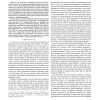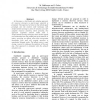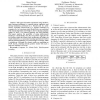93
Voted
ATAL
2005
Springer
15 years 6 months ago
2005
Springer
Designing agents whose behavior challenges human players adequately is a key issue in computer games development. This work presents a novel technique, based on reinforcement lear...
123
Voted
SAC
2005
ACM
15 years 6 months ago
2005
ACM
This paper presents a novel model of reinforcement learning agents. A feature of our learning agent model is to integrate analytic hierarchy process (AHP) into a standard reinforc...
96
Voted
KCAP
2005
ACM
15 years 6 months ago
2005
ACM
We present a framework for knowledge transfer from one reinforcement learning task to a related task through advicetaking mechanisms. We discuss the importance of transfer in comp...
CIG
2005
IEEE
15 years 6 months ago
2005
IEEE
AbstractGroup utility functions are an extension of the common team utility function for providing multiple agents with a common reinforcement learning signal for learning cooperat...
103
Voted
IROS
2006
IEEE
15 years 6 months ago
2006
IEEE
Abstract— This paper presents a learning system that uses Qlearning with a resource allocating network (RAN) for behavior learning in mobile robotics. The RAN is used as a functi...
100
click to vote
IROS
2006
IEEE
15 years 6 months ago
2006
IEEE
— Recently, many researchers on humanoid robotics are interested in Quasi-Passive-Dynamic Walking (Quasi-PDW) which is similar to human walking. It is desirable that control para...
102
Voted
IJCNN
2006
IEEE
15 years 6 months ago
2006
IEEE
Abstract— One of the major challenges in both action generation for robotics and in the understanding of human motor control is to learn the “building blocks of movement genera...
ICARCV
2006
IEEE
15 years 6 months ago
2006
IEEE
— Multi-agent systems are rapidly finding applications in a variety of domains, including robotics, distributed control, telecommunications, etc. Learning approaches to multi-ag...
CIMCA
2006
IEEE
15 years 6 months ago
2006
IEEE
In this paper, a distributed and adaptive approach for resource discovery in peer-to-peer networks is presented. This approach is based on the mobile agent paradigm and the random...
98
Voted
CIG
2006
IEEE
15 years 6 months ago
2006
IEEE
Abstract— This paper describes experiments using reinforcement learning techniques to compute pattern urgencies used during simulations performed in a Monte-Carlo Go architecture...





